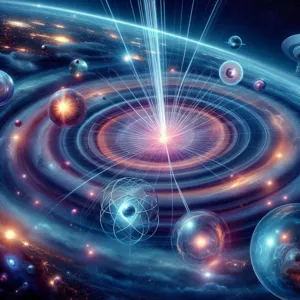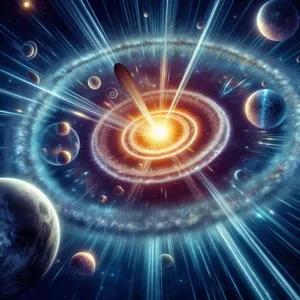The cosmos is a vast and mysterious expanse, filled with wonders that continue to intrigue scientists and stargazers alike.
Among the many phenomena that traverse the universe, cosmic rays stand out as some of the most enigmatic and powerful particles known to humankind. These high-energy particles, originating from sources both near and far, collide with atoms in our atmosphere, creating a cascade of secondary particles that can be detected on Earth. But what exactly are cosmic rays, and where do they come from? In this post, we will delve into the fascinating world of cosmic rays, exploring their various types, from solar cosmic rays to ultra-high-energy cosmic rays, and uncovering the origins of these celestial travelers. Join us on this journey through space and time as we unravel the scientific mysteries of the universe and gain a deeper understanding of the forces that shape our cosmic environment.
1. Introduction to Cosmic Rays: What Are They?

Cosmic rays are one of the universe’s most intriguing phenomena, captivating scientists and curious minds alike with their mysterious origins and powerful impact. At their core, cosmic rays are high-energy particles that race through space at nearly the speed of light, bombarding Earth and other celestial bodies. These particles primarily consist of protons, but they can also include heavier nuclei and electrons, making them a diverse and complex group.
Discovered in the early 20th century, cosmic rays initially puzzled researchers, leading to extensive studies that sought to unravel their origins and effects. They are not just random particles; they are heralds from the vast reaches of our universe, carrying with them vital clues about cosmic events and processes. When these high-energy particles collide with atoms in our atmosphere, they produce a cascade of secondary particles, which can be detected by ground-based and satellite observatories.
The sources of cosmic rays are varied and often extraordinary. They can originate from the sun, known as solar cosmic rays, or from more powerful astrophysical phenomena such as supernovae, black holes, and even the enigmatic processes occurring in distant galaxies. Understanding cosmic rays is fundamental for astrophysics, as they provide insights into high-energy physics, the nature of the universe, and the forces that shape it.
As we delve deeper into the world of cosmic rays, we will explore their classification, the mechanisms behind their acceleration, and the ongoing research aimed at deciphering their cosmic journeys. The study of cosmic rays not only enhances our knowledge of the universe but also has practical implications here on Earth, influencing everything from satellite operations to our understanding of radiation exposure. Join us as we embark on this celestial exploration, uncovering the mysteries that these high-energy messengers bring from the heart of the cosmos.
2. The History of Cosmic Ray Discovery
The history of cosmic ray discovery is a fascinating journey that stretches back over a century, marked by curiosity, innovation, and a series of groundbreaking experiments. It all began in the early 20th century when scientists were grappling with the mysteries of radiation and the structure of the universe. In 1912, the Austrian physicist Victor Franz Hess embarked on a pioneering balloon experiment that would change our understanding of space. Ascending to altitudes of nearly 5,000 meters, Hess measured unexpected levels of radiation that increased with elevation, leading him to conclude that this radiation originated beyond the Earth’s atmosphere. He coined the term “cosmic rays” to describe these enigmatic particles.
Hess’s groundbreaking work laid the foundation for subsequent research and sparked widespread interest in cosmic rays. In the years following his discovery, scientists like Robert Millikan and his team conducted extensive studies to characterize these high-energy particles, leading to the realization that cosmic rays are primarily composed of protons, electrons, and heavy atomic nuclei. The 1930s saw the advent of cloud chambers and other detection technologies, enabling researchers to track the paths of these charged particles and gain insights into their properties.
The mid-20th century brought further advancements, including the identification of cosmic rays as being of both galactic and extragalactic origins. Researchers like Enrico Fermi proposed mechanisms such as supernova explosions and the activity of black holes as potential sources of these high-energy particles. As our understanding evolved, so did our detection methods, with the development of sophisticated satellite instruments that could observe cosmic rays from space, unencumbered by the Earth’s atmosphere.
Today, the study of cosmic rays continues to be a vibrant field of research, delving into the origins of these particles and their impact on both our planet and the broader universe. The history of cosmic ray discovery not only highlights the ingenuity of early 20th-century scientists but also sets the stage for ongoing explorations into the fabric of our cosmos, reminding us that the universe is a vast and dynamic entity, constantly revealing its secrets to those eager to explore.
3. Types of Cosmic Rays: Primary vs. Secondary

When diving into the fascinating realm of cosmic rays, it’s essential to distinguish between the two main types: primary and secondary cosmic rays. Each type has its unique characteristics and origins, contributing to our understanding of the universe.
**Primary Cosmic Rays** are the high-energy particles that originate from outer space, traveling through the vastness of the cosmos before reaching Earth. These particles predominantly consist of protons, but they can also include heavier nuclei such as helium or even ions from heavier elements. The sources of primary cosmic rays are varied, ranging from supernova explosions to active galactic nuclei and even gamma-ray bursts. As these energetic particles traverse space, they can reach astonishing speeds, often approaching that of light itself, making them some of the fastest objects in the universe.
Upon entering the Earth’s atmosphere, primary cosmic rays collide with molecules in the air, leading to a cascade of interactions that results in the production of **secondary cosmic rays**. These particles, while not as energetic as their primary counterparts, play a vital role in the cosmic ray phenomenon. Secondary cosmic rays include a mix of electrons, positrons, muons, and neutrinos, all generated from the interactions of primary cosmic rays with atmospheric particles. This process can create a complex shower of particles that rain down upon the Earth’s surface, detectable by specialized instruments designed to capture their signatures.
Understanding the differences between primary and secondary cosmic rays not only enhances our knowledge of cosmic processes but also sheds light on the mechanisms that govern particle interactions in our atmosphere. By studying these rays, scientists can glean valuable insights into the energy and composition of the universe, unraveling the mysteries that lie beyond our planet.
4. High-Energy Cosmic Rays: Characteristics and Sources
High-energy cosmic rays (HECRs) are among the most enigmatic and powerful entities in the universe, carrying energies that can exceed a billion electron volts—millions of times more energetic than particles produced in the highest-energy human-made accelerators. These cosmic messengers travel through the vast expanses of space and reach Earth from all directions, often showering our atmosphere with a cascade of secondary particles upon their arrival.
One of the defining characteristics of HECRs is their composition, which primarily includes protons, but can also contain heavier atomic nuclei, such as helium and even iron. The origin of these energetic particles is still a subject of extensive research and debate within the scientific community. It is believed that many high-energy cosmic rays are produced in extreme astrophysical environments, such as supernova explosions, which are the cataclysmic deaths of massive stars. During these events, shock waves can accelerate particles to incredible velocities, propelling them into interstellar space.
Another significant source of HECRs is active galactic nuclei (AGN), which harbor supermassive black holes at their centers. The intense gravitational forces and high-energy processes occurring in these regions can generate cosmic rays that travel vast distances across the universe. Additionally, gamma-ray bursts, which are among the most violent explosions observed in the universe, are also thought to be potent sources of high-energy cosmic rays.
As researchers continue to study these cosmic phenomena using advanced telescopes and detectors, they aim to unravel the mysteries surrounding the origins of HECRs and the fundamental processes that govern their behavior. Understanding high-energy cosmic rays not only sheds light on the high-energy universe but also has implications for astrophysics, particle physics, and even space weather, making them a captivating subject in the quest to explore the cosmos.
5. Low-Energy Cosmic Rays: Characteristics and Sources

Low-energy cosmic rays (LECRs) are a fascinating aspect of cosmic radiation, generally defined as particles with energies below about 1 giga-electronvolt (GeV). Unlike their high-energy counterparts, which can be traced back to explosive cosmic events such as supernovae or active galactic nuclei, LECRs present a more nuanced origin story that intertwines with our own solar system.
These rays primarily consist of protons, but they also include a small fraction of heavier nuclei and electrons. One of their defining characteristics is their relatively low velocity, which allows them to interact more readily with interstellar matter. This interaction leads to a phenomenon known as ionization, where these particles can strip electrons from atoms, potentially influencing the chemistry of the space through which they travel.
When it comes to their sources, LECRs are thought to originate from a combination of solar activity and local astrophysical processes. For instance, during solar flares, the Sun emits a barrage of particles that can be accelerated and released into the interstellar medium. Additionally, the interaction of cosmic rays with interstellar gas can produce secondary particles, contributing to the background of LECRs observed throughout space.
Interestingly, some theories suggest that LECRs can also be generated by shock waves from supernova remnants as they expand into the surrounding interstellar medium. These shock waves can accelerate particles to lower energies, allowing them to become part of the LECR population.
Studying low-energy cosmic rays is crucial for understanding the broader cosmic environment. They play a significant role in space weather, influencing the radiation environment that spacecraft and astronauts encounter. Furthermore, by analyzing LECRs, scientists can gain insight into the local and galactic processes that shape our universe. As we continue to explore the cosmos, these seemingly mundane particles remind us of the intricate and dynamic nature of the space we inhabit.
6. The Role of Supernovae in Cosmic Ray Production
Supernovae are among the most spectacular and powerful events in the universe, and they play a pivotal role in the production of cosmic rays. When a massive star exhausts its nuclear fuel, it can no longer support itself against gravitational collapse. The core implodes, triggering a catastrophic explosion that expels the star’s outer layers into space at incredible speeds. This explosive event not only marks the death of the star but also creates conditions ripe for cosmic ray generation.
During a supernova, the shock waves produced by the explosion propagate through the surrounding interstellar medium, heating it up and compressing the gas to extreme densities. In this tumultuous environment, particles such as protons and heavier nuclei are accelerated to nearly the speed of light. This acceleration occurs through a process known as diffusive shock acceleration, where particles gain energy by repeatedly crossing the shock front of the expanding supernova remnant.
The energy of these cosmic rays can be astonishing; some are thought to reach energies far beyond what can be achieved in terrestrial particle accelerators. This immense energy means that supernovae are a significant source of high-energy cosmic rays that contribute to the overall cosmic ray flux observed on Earth.
Moreover, supernova remnants—those glowing shells of gas and dust left behind after the explosion—can continue to accelerate particles long after the initial explosion has ended. These remnants expand over time, interacting with the interstellar medium and creating a dynamic environment that perpetuates cosmic ray production for thousands of years.
Understanding the role of supernovae in cosmic ray production not only sheds light on the nature of these high-energy particles but also provides insights into the life cycles of stars and the complex dynamics of our galaxy. As researchers continue to study supernova remnants and their interactions, they uncover the intricate connections between stellar evolution and the cosmic radiation that permeates our universe, reminding us of the explosive forces that continuously shape the cosmos.
7. Active Galactic Nuclei and Their Contribution to Cosmic Rays

Active Galactic Nuclei (AGN) are among the most powerful and enigmatic phenomena in the universe, playing a pivotal role in the generation of cosmic rays. These regions, which host supermassive black holes at the centers of galaxies, are characterized by their extraordinary energy output and unique spectral signatures. As matter spirals into the black hole, it accelerates and heats up, emitting vast amounts of radiation across the electromagnetic spectrum—from radio waves to gamma rays. This intense activity creates a dynamic environment where particles are accelerated to near-light speeds, resulting in the production of high-energy cosmic rays.
The contribution of AGN to cosmic rays is particularly significant. Evidence suggests that they are one of the primary sources of ultra-high-energy cosmic rays, which are the most energetic particles observed in nature. These particles, often exceeding energies of 10^20 electronvolts, are thought to be generated in the relativistic jets that AGN emit. These jets, composed of charged particles, can extend far beyond the host galaxy, interacting with intergalactic matter and magnetic fields, further contributing to the cosmic ray population.
Moreover, the processes occurring in AGN are not isolated. They interact with their surrounding environment, including the interstellar medium and other cosmic structures, leading to additional particle acceleration mechanisms. As these cosmic rays travel through the universe, they carry vital information about the extreme conditions prevalent in AGN, offering insights into the fundamental physics governing these celestial giants.
In summary, Active Galactic Nuclei serve as cosmic laboratories where the mysteries of particle acceleration and high-energy astrophysics unfold. Their contribution to the cosmic ray spectrum not only enhances our understanding of the universe but also challenges our perceptions of fundamental astrophysical processes, making them a critical focus of ongoing research in the field of astrophysics.
8. The Influence of the Sun: Solar Cosmic Rays Explained
Among the myriad sources of cosmic rays that permeate our universe, the Sun stands out as a significant contributor, particularly through what we identify as solar cosmic rays. These energetic particles are primarily composed of protons and electrons, which are ejected from the Sun’s atmosphere during periods of solar activity, such as solar flares and coronal mass ejections.
Solar cosmic rays are fascinating not only for their origins but also for their impact on our planet. When the Sun undergoes heightened activity, it can release a burst of these charged particles, sending them hurtling through space at astonishing speeds—often approaching the speed of light. When these particles reach Earth, they can interact with our atmosphere, leading to a cascade of secondary particles that may even reach the surface. This natural phenomenon is a testament to the dynamic and sometimes volatile nature of our nearest star.
The effects of solar cosmic rays can be both intriguing and concerning. For instance, during strong solar storms, these particles can disrupt satellite communications, pose risks to astronauts in space, and even influence technological systems on Earth. Moreover, they contribute to the natural background radiation that we experience on the planet.
Understanding solar cosmic rays is crucial for scientists as they study space weather and its potential impacts on technology and human activities. By monitoring solar activity and the subsequent release of cosmic rays, researchers can better predict solar storms and prepare for their effects on Earth. Thus, the influence of the Sun extends beyond mere illumination; it reaches into the very fabric of our atmosphere and the technology we rely on every day, underscoring the intricate connections between our planet and the cosmos.
9. Understanding Galactic Cosmic Rays
Galactic cosmic rays (GCRs) are among the most fascinating phenomena in the cosmos, offering incredible insights into the workings of our universe. These high-energy particles, predominantly consisting of protons, are thought to originate from outside our solar system, primarily in our Milky Way galaxy. As they travel through the vast expanses of space, they can reach astonishing speeds, often exceeding 99.9% of the speed of light.
The origins of GCRs are believed to be linked to explosive cosmic events, such as supernovae and the interactions of high-energy particles with magnetic fields in pulsars and other astrophysical objects. When massive stars exhaust their nuclear fuel, they undergo catastrophic explosions, releasing enormous amounts of energy that can accelerate protons and heavier atomic nuclei to relativistic speeds. This particle acceleration process is critical to the generation of GCRs, as it injects them into the interstellar medium, where they can traverse the galaxy for millions of years before potentially reaching Earth.
When GCRs enter our atmosphere, they collide with air molecules, resulting in cascades of secondary particles that can be detected at ground level. These interactions not only help scientists study the composition and energy of GCRs but also provide valuable information about cosmic processes at play throughout the universe. Understanding GCRs can also shed light on the magnetic fields and other forces that govern the structure of galaxies.
Moreover, GCRs play a significant role in space exploration, as they pose a radiation hazard to astronauts venturing beyond Earth’s protective atmosphere. As space agencies prepare for long-duration missions to Mars and beyond, comprehending the behavior and effects of galactic cosmic rays becomes increasingly vital. With ongoing research and advancements in detection technologies, scientists continue to unravel the mysteries of these enigmatic particles, deepening our understanding of the cosmos and its intricate dynamics.
10. The Impact of Cosmic Rays on Earth’s Atmosphere
Cosmic rays, high-energy particles originating from outer space, continuously bombard Earth’s atmosphere, creating a complex and dynamic interaction that has far-reaching implications. These energetic particles, which can include protons, atomic nuclei, and even heavier ions, travel at nearly the speed of light and collide with molecules in the atmosphere, initiating a cascade of secondary particles that permeate the air we breathe.
When cosmic rays enter the Earth’s atmosphere, they collide with nitrogen and oxygen molecules, producing a shower of secondary particles including muons, electrons, and gamma rays. This process not only generates a unique type of radiation but also plays a significant role in atmospheric chemistry. For instance, these interactions can lead to the formation of nitrogen oxides, which influence cloud formation and, consequently, weather patterns.
Moreover, cosmic rays contribute to the ionization of the atmosphere, creating charged particles that can affect the electrical properties of the air. This ionization process is essential for various atmospheric phenomena, including the formation of lightning. Some studies suggest that variations in cosmic ray intensity may even correlate with changes in global climate, offering a fascinating glimpse into the intricate connections between cosmic events and terrestrial conditions.
In addition to their impact on weather and climate, cosmic rays also pose a challenge for modern technology and human health. Satellites and spacecraft, for instance, need to be designed to withstand the bombardment of these high-energy particles, as they can interfere with electronic systems and damage sensitive equipment. On Earth, while the atmosphere provides a protective shield against most cosmic radiation, increased exposure to cosmic rays at high altitudes or during air travel can raise health concerns for frequent flyers and airline crew members.
Understanding the impact of cosmic rays on Earth’s atmosphere not only sheds light on the intricate workings of our planet’s climate systems but also highlights the importance of ongoing research in astrophysics and atmospheric science. By delving into the origins and effects of these enigmatic particles, we gain a deeper appreciation for the cosmic forces that shape our environment and the delicate balance that sustains life on Earth.
11. Cosmic Rays and Space Weather: Implications for Satellites and Astronauts
Cosmic rays—high-energy particles originating from beyond our solar system—carry with them not just fascinating scientific mysteries but also significant implications for our technology and human exploration of space. As these particles traverse the cosmos and enter Earth’s atmosphere, they can pose serious risks to satellites and astronauts, making their understanding crucial in the realm of space weather.
Satellites, which are integral to global communication, navigation, and weather forecasting, are particularly vulnerable to cosmic rays. These energetic particles can disrupt electronic circuits, degrade sensors, and lead to data corruption. This interference can result in temporary outages or permanent damage, potentially leading to costly repairs or replacements. Engineers and scientists thus need to design satellites with shielding and redundancy systems to mitigate these risks. Understanding the patterns and intensity of cosmic rays can help in scheduling critical operations during periods of lower cosmic activity, protecting these vital assets.
For astronauts venturing beyond the protective embrace of Earth’s atmosphere, the stakes are even higher. Exposure to cosmic rays can increase the risk of cancer, damage the central nervous system, and impair cognitive functions. Long-duration missions, such as those planned for Mars, necessitate careful consideration of radiation exposure. Space agencies are investing in research to develop better shielding for spacecraft and habitats, as well as monitoring systems to provide real-time data on cosmic ray levels.
Moreover, during solar flares or coronal mass ejections—events that characterize space weather—solar particles can amplify the risks posed by cosmic rays. This dual threat underscores the importance of predicting space weather events to ensure astronaut safety and the operational integrity of satellites.
In essence, the interplay between cosmic rays and space weather is a critical area of study, influencing everything from mission planning to spacecraft design. As we continue to explore the cosmos, understanding and preparing for these energetic particles will be essential for the safety and success of our ventures into the final frontier.
12. Methods of Detecting and Studying Cosmic Rays
Detecting and studying cosmic rays is a fascinating endeavor that combines cutting-edge technology with a deep understanding of astrophysics. Cosmic rays, high-energy particles that originate from outer space, bombard the Earth’s atmosphere continuously, yet their detection poses significant challenges due to their elusive nature. Scientists employ several sophisticated methods to capture these particles and analyze their properties.
One of the most common methods involves the use of ground-based detectors, such as large arrays of scintillation counters or Cherenkov radiation detectors. These systems work by measuring the secondary particles produced when cosmic rays collide with atoms in the Earth’s atmosphere. For instance, extensive air shower arrays, like the Pierre Auger Observatory in Argentina, cover vast areas of land to detect the faint traces of energy released from billions of cosmic rays interacting with the atmosphere. By analyzing the patterns of secondary particles, researchers can infer the energy and composition of the primary cosmic rays.
Another innovative approach is the use of balloons and satellites equipped with specialized instruments that can operate above the dense layers of Earth’s atmosphere. These platforms, such as the Alpha Magnetic Spectrometer (AMS-02) aboard the International Space Station, allow scientists to measure cosmic rays with unprecedented precision. By capturing the individual particles and analyzing their charge and mass using magnetic fields, researchers can gain insights into the origins and behavior of these high-energy phenomena.
The study of cosmic rays also employs sophisticated particle detectors, including liquid ionization chambers and solid-state detectors, which can be used in laboratory settings to analyze cosmic ray interactions. This allows scientists to simulate and study the conditions that cosmic rays encounter in space, shedding light on their sources, whether they be supernovae, pulsars, or distant active galactic nuclei.
In recent years, machine learning algorithms have been introduced to analyze the massive datasets generated from cosmic ray observations, enabling the identification of patterns and correlations that were previously undetectable. This intersection of astrophysics and data science is revolutionizing our understanding of cosmic rays and paving the way for new discoveries.
By employing these methods, scientists continue to unravel the mysteries of cosmic rays, uncovering their origins and the role they play in the broader context of the universe. As detection technologies advance, our knowledge of these enigmatic particles will undoubtedly expand, revealing even more about the cosmos that surrounds us.
13. The Future of Cosmic Ray Research
As we stand on the brink of a new era in cosmic ray research, the future holds exciting possibilities that promise to deepen our understanding of the universe. Advances in technology, coupled with innovative research methodologies, are set to revolutionize how we study these enigmatic particles that travel across vast cosmic distances.
One of the most anticipated developments is the deployment of next-generation observatories designed to capture and analyze cosmic rays with unprecedented precision. Facilities like the Extremely Large Telescope (ELT) and the upcoming space-based observatories are expected to provide enhanced observational capabilities. These instruments will facilitate the study of high-energy cosmic rays, potentially shedding light on their origins and the astrophysical processes that accelerate them.
Moreover, collaboration between international research teams is becoming increasingly vital. Projects like the Pierre Auger Observatory in Argentina and the IceCube Neutrino Observatory in Antarctica highlight the importance of global partnerships in tackling complex questions about cosmic rays. By pooling resources and expertise, scientists can enhance data collection and interpretation, paving the way for groundbreaking discoveries.
In addition, the integration of artificial intelligence and machine learning into cosmic ray research is poised to transform data analysis. These technologies can sift through vast amounts of data to identify patterns and anomalies that might otherwise go unnoticed, potentially leading to the discovery of new types of cosmic rays or unexpected sources of their acceleration.
As we continue to explore the cosmos, the quest to understand cosmic rays not only deepens our knowledge of the universe but also challenges our perceptions of fundamental physics. With every discovery, we move closer to unraveling the mysteries of high-energy particles, their origins, and their role in the dynamic tapestry of the cosmos. The future of cosmic ray research is bright, and the journey ahead promises to be as thrilling as the discoveries that await us.
14. The Importance of Cosmic Rays in Astrophysics
Cosmic rays, those high-energy particles that traverse the universe and rain down upon Earth, are more than just a curiosity of the cosmos; they are crucial to our understanding of astrophysics. These elusive particles, primarily composed of protons, electrons, and atomic nuclei, come from various sources, including the Sun, supernovae, and even distant galaxies. But why do cosmic rays hold such significance in the realm of astrophysics?
Firstly, cosmic rays serve as a natural laboratory for studying high-energy physics. When these particles collide with atoms in the Earth’s atmosphere, they produce secondary particles and radiation, allowing scientists to investigate fundamental processes that occur under extreme conditions. Observing these interactions not only sheds light on the nature of the universe at large but also helps refine our understanding of particle physics, challenging existing theories and prompting the development of new ones.
Furthermore, cosmic rays act as messengers from the far reaches of the universe, providing valuable information about their origins and the environments they traverse. By analyzing the composition and energy spectra of cosmic rays, astrophysicists can glean insights into phenomena such as supernova explosions, active galactic nuclei, and even the mysterious dark matter that permeates the cosmos. Each cosmic ray carries with it a story of its journey across the universe, revealing clues about the processes that govern its creation and the cosmic events that shape our universe.
Additionally, the study of cosmic rays has implications beyond just understanding the cosmos; it can also inform us about space weather and its effects on human technology and health. High-energy cosmic rays can pose a significant risk to astronauts in space and can disrupt satellite operations and communication systems on Earth. By studying these particles, scientists can develop better predictive models for space weather, ultimately safeguarding both our technology and our exploration efforts.
In summary, cosmic rays are far more than mere particles; they are the key to unlocking a deeper comprehension of the universe’s workings. Through their study, astrophysicists can delve into the origins of cosmic phenomena, probe the fundamental laws of physics, and enhance our ability to navigate the challenges of space exploration. As we continue to explore the cosmos, cosmic rays will undoubtedly remain a focal point of research, illuminating the mysteries of the universe one particle at a time.
15. Conclusion: The Ongoing Mystery of Cosmic Rays and Their Origins
In conclusion, the exploration of cosmic rays remains a captivating frontier in the field of astrophysics, steeped in mystery and intrigue. As we have traversed the various types of cosmic rays—ranging from the high-energy protons and nuclei that pierce our atmosphere to the enigmatic, lesser-known particles that challenge our understanding of the universe—we find ourselves at the cusp of groundbreaking discoveries. Despite decades of research, the origins of these cosmic messengers continue to elude us, prompting scientists to delve deeper into the cosmos.
Theories abound regarding their sources, from supernova explosions and pulsars to the enigmatic realms of active galactic nuclei. Each theory presents its own set of challenges and questions, compelling researchers to gather data and conduct experiments that push the boundaries of our knowledge. The ongoing advancements in detection technology and observational techniques are vital, offering fresh insights into the nature of cosmic rays and their impact on both our planet and the broader universe.
As we stand on the brink of a new era in cosmic ray research, the quest for understanding these high-energy particles is more critical than ever. Not only do cosmic rays hold clues to the fundamental workings of our universe, but they also influence atmospheric chemistry and may even have implications for space travel and human health. The journey into the depths of space continues to inspire awe and curiosity, inviting scientists and enthusiasts alike to ponder the unknown and seek answers to questions that have bewildered humanity for centuries. In this cosmic tapestry, the threads of mystery remain intertwined, urging us to explore further and embrace the wonders that lie beyond our earthly confines.
As we conclude our journey through the fascinating world of cosmic rays, we hope you’ve gained a deeper appreciation for these high-energy particles that constantly bombard our planet. From solar cosmic rays originating from our sun to the more mysterious galactic and extragalactic cosmic rays that traverse vast expanses of space, each type offers unique insights into the workings of our universe. Understanding their origins not only enhances our knowledge of astrophysics but also sheds light on the fundamental processes that govern the cosmos. Whether you’re a seasoned astronomer or a curious novice, we encourage you to continue exploring this captivating field. The universe is full of wonders waiting to be discovered, and who knows what secrets the next cosmic ray might reveal? Thank you for joining us on this celestial adventure!






